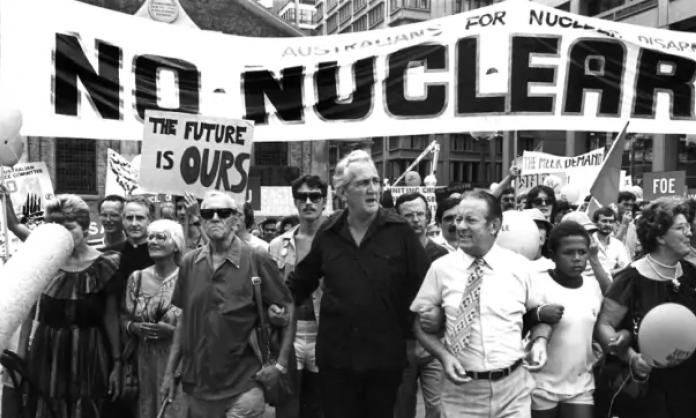“Uranium cannot be mined without workers, it cannot be transported without them, the mines cannot be supplied without them.” These were the words of Jeff Wallmann, a shop steward at the Williamstown naval dockyards in Melbourne and a member of the International Socialists, writing in an anti-nuclear newsletter circulated and read by union militants.
The Movement Against Uranium Mining, which published the newsletter, succeeded in bringing together workers, radicals and community activists, all united by a common opposition to the deadly uranium industry. It consisted of dozens of local community campaign groups that involved socialists, environmentalists, Labor left activists and many others. It encouraged and supported rank and file unionists defying their officials and the ACTU over the issue of uranium mining.
Many unions ended up taking some action as part of the campaign, including the railway unions, the waterside workers, the seamen, postal and telegraph, the Building Workers Industrial Union, teachers, transport workers, power workers, metalworkers and the electrical trades. A “Public Servants Against Uranium” group was also set up. The movement successfully pressured the ALP and the ACTU to come out in opposition to uranium mining, and it helped establish the connection between uranium mining, nuclear energy and nuclear weapons in the broader public consciousness.
**********
In September 1974 a conference of power workers made a statement to the press that said under no circumstances would they work in any nuclear power stations until the problem of nuclear pollution was solved. Everyone knew that the waste from the nuclear industry lasts for hundreds of thousands of years, and no one had any solution to what was going to be done with it.
In November, Friends of the Earth and the Australian Conservation Foundation met with the ACTU to argue it should ban uranium mining. A December meeting of transport, construction and manufacturing industry workers recommended “pending adoption of safe procedures acceptable to the trade unions, the ACTU exec should impose a black ban on the development, mining, treatment and export of uranium”.
At the time, Labor prime minister Gough Whitlam was planning to open uranium mines. Bob Giles, the federal president of the plumbers’ and gas fitters’ union, spoke out against him, saying: “There is only one socially responsible use for uranium, and that is to leave it in the ground”. In March 1975, the metalworkers – a very important union – declared they were going to oppose anything to do with the mines.
In September 1975, the ACTU and the white collar peak union body (they later amalgamated), both adopted anti-uranium policies, but only “in principle”. If you know anything about unions, you’ll know what that means. It was very vague.
In May 1976, the issue hit the headlines. Jim Assenbruck, a railway worker in Townsville, refused to load material that was to go to the Mary Kathleen mine, as the railway union had just adopted a policy that banned anything to do with uranium mines. Jim was stood down; workers began walking off on strike everywhere, and there was a national strike of railway workers. This action is widely considered to be the first anti-nuclear strike anywhere in the world.
This put the movement on the front foot. I was living in Queensland at the time and was not active, but I heard about Jim Assenbruck. People were starting to talk about the issue. During 1977 they started moving yellowcake (uranium oxide ore) out through the Sydney port. Truckloads of yellowcake were known to be careening down city streets in the middle of the night, sometimes going the wrong direction down one-way streets, escorted by state and federal police. On 20 June, demonstrators invaded the dock, and the rank and file wharfies stopped work because they agreed with us and also wanted to stop the ore leaving. The ACTU’s ambivalent position was used by the officials to get workers back to work eventually, but it was big news nonetheless.
Two weeks later on the Melbourne docks, there was a big stoush, and 40 people were arrested. The violence of the cops shocked heaps of people, including the dock workers. There was a ship called the Columbus Australia going to the US carrying yellowcake. The Waterside Workers Federation locally defied the union’s federal leaders by banning this ship and called a port-wide 24-hour strike. They refused to touch any more cargoes of uranium, and the authorities never tried to bring uranium through the Melbourne docks again.
**********
I went to my first demonstration in late August 1977. It was called in response to prime minister Fraser saying “We’ve given the green light to uranium, it’s going ahead”. There I discovered that you didn’t even have the right to walk on the footpath if you were protesting in Queensland. I very nearly got arrested that night, and afterwards I started attending meetings to organise the next demonstration.
By then it was well established that the unions were really important to this movement. It was clear that union action could stop uranium mining, in a way community campaigning – important though it was – could not. The equivocal stance of the peak union bodies meant it was crucially important that activists were prepared to be defiant and militant, and to interpret their leaders’ ambiguity in the way they wanted – that is, as endorsement of anti-uranium action.
We would frequently go to the wharves to picket. There might not be many of us, but if we heard that there was a load arriving, we would go. The police would of course miraculously turn up, and so then the wharfies would refuse to walk through police lines. The presence of uranium created havoc on the docks. Sometimes we would invade the docks, and the wharfies would use our presence to stop work on the basis of the safety risk we posed, which would hold up loads of cargo for at least a day. We weren’t actually stopping uranium leaving, but it was still a huge annoyance for the companies.
In those days we were able to visit workplaces, so we spent a lot of time visiting and speaking to workers. I have vivid memories of going to talk to meat workers who would have their lunch in their blood-stained aprons, and the shop steward would say “OK, everyone shut up, put your cards down”, and I would speak about uranium mining and someone with me would speak about the civil liberties campaign. The amazing thing to me was how generous workers were even though they were on quite low wages. No matter where you went, people always listened, engaged in the discussion and then donated heaps of money.
In 1979 I moved to Melbourne and organised a workplace tour of a miner I met in Mount Isa on Hiroshima Day in 1978. We visited all kinds of factories and workplaces, wherever we could get into. It was really becoming a big issue. And while our orientation was to the rank and file, we didn’t ignore the officials. In late 1979 the campaign had a big victory against then-ACTU president Bob Hawke – who militants hated – at the ACTU congress. The congress was a sea of little yellow dots because so many people were wearing the campaign’s yellow “black ban uranium” badge.
The delegates voted against Hawke’s attempt to water down the ACTU’s policy on uranium mining. It was a big defeat for him, and he was pretty taken aback. It was one of the only times he was ever beaten.
**********
As the 1970s became the 1980s, the political climate changed, and things became more difficult for the movement. Nevertheless, in mid-1981 seamen in Sydney stopped two ships leaving with uranium, while in Brisbane, $8 million worth of uranium was held up by railway and maritime workers and remained stranded on the docks for weeks. In the Northern Territory, the company operating the Nabarlek uranium mine and mill was forced to pay millions of dollars to charter helicopters to get the uranium out and to charter foreign ships to avoid the wharves.
There was one final stand by the waterside workers, transport workers and seamen in Darwin. For six weeks from mid-October 1981, no ship left the docks carrying ore from the uranium mines. There were rumours that the bosses were mobilising a scab workforce, and Fraser had been indicating for some time that he was prepared to use troops to get the uranium out through the docks. Shamefully, the ACTU stepped in and argued to end the bans. The workers felt isolated and eventually gave in, but it was a huge stand-off for six weeks.
Some of the lessons I took from this experience were, firstly, that a strong union movement is crucial, and within that, so is a left that is prepared to defy governments and pressure the officials to give greater support to members taking action. Without this, we couldn’t have won anything.
There is an argument today in the climate change movement that with 3.5 percent of the population prepared to disrupt city streets we could force governments to act. While this would be an important start, police violence and repression will likely crush a movement just based on the streets today. When workers are well enough organised to actually stop economic activity, it raises the stakes considerably. There is the possibility that the victimisation of workers or activists will draw in greater layers of workers in solidarity, further disrupting the economy. This has happened in Australian history, and is what we need to aspire towards today to have a real chance of forcing the destructive agenda of the capitalist class back.
Secondly, militancy gets results and inspires others to take more determined action. Without students, community groups and others taking disruptive action, it’s unlikely workers would have taken the stand they did. They often had to hear our arguments, and it was clear that they took us seriously and wanted to support us because they knew we were putting ourselves on the line, including getting arrested when necessary.
Finally, it mattered that community groups included left Labour activists (who were actually left wing in those days) and Communists who organised support for workers on strike. So a vital task today is to rebuild both street militancy and the unions. Fatalistic acceptance of the unions’ current weak state will condemn us to losing future battles.
We didn’t stop uranium mining, but we delayed it. And we created wide awareness amongst workers and the general public about the dangers of the industry. Still today, this provides some protection against the expansion of this deadly industry.
----------
Edited excerpt from a speech delivered at Marxism 2019 conference held over Easter 2019. Transcription by Eleanor Morley.











